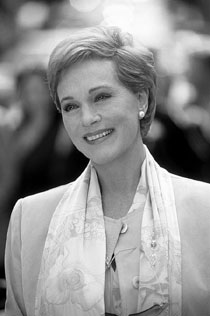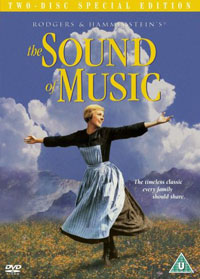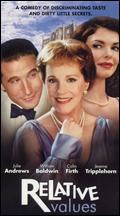影片对白 Majesty, it was I who told the press about the princess, about you.
文化面面观
Julie Andrews 朱丽•安德鲁斯

Born: Oct 01, 1935 in Walton-on-Thames, Surrey, England, UK
Occupation: Actor
Active: '60s-2000s
Major Genres: Comedy, Children's/Family
Career Highlights: The Sound of Music, Victor/Victoria, Mary Poppins
First Major Screen Credit: Cinderella (1957)
The British actress, comedienne, singer and dancer Julie Andrews stakes a claim to fame for having one of the single most astonishing voices (four octaves (四个八度)!) of any entertainer alive. Yet the breadth of this raw ability is often hugely obscured by Andrews's milquetoast image and onscreen persona. Thus, in the late '60s, Andrews - who began her film career rooted firmly in family-oriented material - traveled far out of her way to expand her dramatic repertoire, with decidedly mixed results.
A music-hall favorite since childhood, Andrews spent the war years dodging Nazi bombs and bowing to the plaudits of her fans. Thanks to her own talents and the persistence of her vaudevillian parents, Andrews maintained her career momentum with appearances in such extravaganzas as 1947's Starlight Roof Revue. It was in the role of a 1920s flapper in Sandy Wilson's satire The Boy Friend (1953) that brought Andrews to Broadway; and few could resist the attractively angular young miss warbling such deliberately sappy lyrics as "I Could Be Happy With You/If You Could Be Happy With Me." Following a live-TV performance of High Tor, Andrews regaled American audiences in the star-making role of cockney flower girl Eliza Doolittle in the 1956 Broadway blockbuster My Fair Lady. The oft-told backstage story of this musical classic was enough to dissuade anyone from thinking that Andrews was an overnight success, as producer Moss Hart mercilessly drilled her for 48 hours to help her get her lines, songs and dialect in proper working order. In 1957, Andrews again enchanted TV audiences in the title role of Rodgers & Hammerstein's musical adaptation of Cinderella. Later, Alan Jay Lerner and Frederick Loewe -- also the composers of My Fair Lady -- developed the role of Guinevere in their 1960 musical Camelot with Andrews in mind, and the result was another Broadway triumph, albeit not as profitable as Fair Lady.

Although a proven favorite with American audiences thanks to her frequent TV variety show appearances (notably a memorable 1962 teaming with Carol Burnett), Andrews did not make a motion picture until 1964. As Mary Poppins, Andrews not only headlined one of Walt Disney's all-time biggest moneymakers, but also won an Oscar -- sweet compensation for having lost the Eliza role to Audrey Hepburn for the adaptation of My Fair Lady. Andrews hoped that Mary Poppins would not type her in "goody-goody" parts, and, to that end, accepted a decidedly mature role as James Garner's love interest in The Americanization of Emily (1964). However, Andrews' next film, The Sound of Music (1965) effectively locked her into sweetness and light parts in the minds of moviegoers. On the strength of the success of Music, Andrews was signed to numerous Hollywood projects, but her stardom had peaked.
Perhaps recognizing this, Andrews started to branch out fairly aggressively by the late '60s, with such "adult-oriented" pictures as Alfred Hitchcock's espionage thriller Torn Curtain. That film, and others (Hawaii, Star!) all flopped. In the late '60s, Andrews fell in love with and married the then white-hot American director Blake Edwards; her decision to collaborate with Edwards on a professional level, to boot, waxed incredibly strategic. Today, many view

Edwards in a negative light for cranking out moronic studio fodder such as A Fine Mess and Sunset. In 1969, however, he sat among Hollywood's creme-de-la-creme, notorious for crafting mature genre pictures for adult audiences (The Days of Wine and Roses, Breakfast at Tiffany's, Experiment in Fear) and sophisticated slapstick comedies unafraid to take chances (the Pink Panther series, The Party). By marrying Edwards and aligning herself with him creatively, then, Andrews was also consciously or unconsciously bucking to change her image. Unfortunately, the two began at a low ebb to end all low ebbs. The WWI musical farce Darling Lili (1970) featured Rock Hudson, electric musical numbers, stunning dogfight sequences, and - significantly - a semi-erotic striptease number by Andrews. Apparently audiences didn't buy this sort of behavior coming from Mary Poppins: the film tanked at the box office, as did the spy thriller The Tamarind Seed, also starring Andrews.
Aside from a couple of televised musical specials, Andrews stuck with her husband for each successive film - for better or worse, as they say. Their next collaborations arrived in the late '70s and early '80s, first with the smash Dudley Moore sex farce '10' (1979) and then with the Hollywood satire S.O.B. (1981). In the former, Andrews took a backseat to sexy bombshell Bo Derek, who catches the infatuation of Moore but delivered a finely-modulated comic

performance nonetheless; the latter - an unapologetically 'R' rated comedy about a nutty director who attempts to turn a family-friendly stinker into a porno musical -- exposed a topless Andrews to the world for the first time. This rank, cynical and angry "satire" represented the couple's creative nadir; one critic rightly pointed out that Andrews could have used it as grounds for divorce. The 1982 transvestite musical Victor/Victoria (with Andrews in the lead) fared better; it was followed by Edwards's 1983 Truffaut remake, The Man Who Loved Women (with Andrews as the lover of sculptor Burt Reynolds). Andrews's attempts at image-extending here are obvious in each case; the individual films have various strengths and weaknesses, but - love 'em or hate 'em -- they broadened the appeal of Andrews only slightly - with many perceiving her as either an onscreen accessory to her husband or as an okay straight man in mediocre romantic comedies. The couple fared a thousand times better with the excellent mid-life crisis comedy-drama That's Life! (1986), starring Andrews and Jack Lemmon.
Two esteemed dramatic roles sans Edwards - that of a frustrated multiple sclerosis victim in Duet for One (1986), and that of a grieving mother of an AIDS victim in Our Sons (1991) - did what the prior films were supposed to have done: they secured Andrews's reputation as an actress of astonishing versatility. Yet, as Andrews aged, she ironically began to segue back into the types of roles that originally brought her infamy, with a series of sugar-coated, grandmotherly parts in family-friendly pictures. Notably, she co-starred in the first two installments of The Princess Diaries as Queen Clarisse Renaldi, a European monarch of a tiny duchy, who tutors her "hip" teen granddaughter (Anne Hathaway) in the ways of regality. Andrews also used her polished and cultured British diction to great advantage by voicing Queen Lillian in the second and third installments of Dreamworks's popular, CG-animated Shrek series: Shrek 2 (2004) and Shrek the Third. (Hal Erickson, All Movie Guide)
考考你
用今日所学将下面的句子译成英语。
1. 我上班迟到了,不要告发我!
2. 尽管她没有经验,但她能巧妙地克服这些困难。
The princess diaries《公主日记》1 精讲之三 考考你 参考答案
1. 他当着她的面摔上了门。
He slammed the door in her face.
2. 他宁可自杀,也不叛投敌人。
He committed suicide rather than sell out to the enemy.
3. 看我变身成佩内洛普•克鲁兹!
See me morph into Penelope Cruz!
影片对白 Majesty, it was I who told the press about the princess, about you.
点击进入:更多精彩电影回顾
(英语点津Annabel编辑)